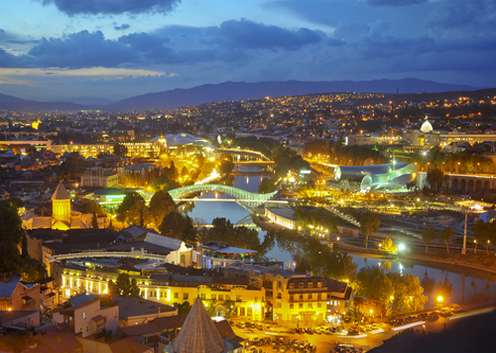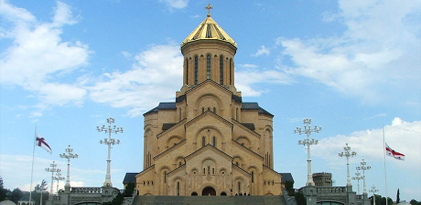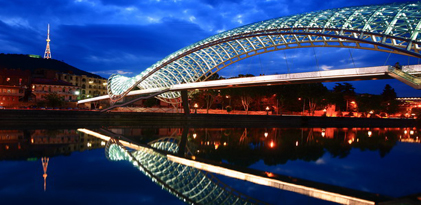Tbilisi commonly known by its former name Tiflis and often mispronounced as Tiblisi, is the capital and the largest city of Georgia, lying on the banks of the Kura River with a population of roughly 1.5 million inhabitants. Founded in the 5th century by the monarch of Georgia's ancient precursor the Kingdom of Iberia, Tbilisi has since served, with intermissions, as the capital of various Georgian kingdoms and republics. Under Russian rule, from 1801 to 1917 Tiflis was the seat of the Imperial Viceroy governing both sides of the entire Caucasus. Located on the crossroads of Europe and Asia, Tbilisi's proximity to lucrative east-west trade routes often made the city a point of contention between various rival empires throughout history and the city's location to this day ensures its position as an important transit route for global energy and trade projects. Tbilisi's varied history is reflected in its architecture, which is a mix of medieval, classical, Middle Eastern, Art Nouveau, Stalinist and Modernist structures. Historically, Tbilisi has been home to people of diverse cultural, ethnic, and religious backgrounds, though it is overwhelmingly Eastern Orthodox Christian. Notable tourist destinations include cathedrals like Sameba and Sioni, classical Freedom Square, Rustaveli Avenue and Agmashenebeli Avenue, medieval Narikala Fortress, pseudo-Moorish Opera Theater, and the Georgian National Museum. Georgia is a country in the Caucasus region of Eurasia. Located at the crossroads of Western Asia and Eastern Europe, it is bounded to the west by the Black Sea, to the north by Russia, to the south by Turkey and Armenia, and to the southeast by Azerbaijan. The capital and largest city is Tbilisi. Georgia covers a territory of 69,700 square kilometres (26,911 sq mi), and its 2015 population is about 3.75 million. Georgia is a unitary, semi-presidential republic, with the government elected through a representative democracy. During the classical era, several independent kingdoms became established in what is now Georgia. The kingdoms of Colchis and Iberia adopted Christianity in the early 4th century. A unified Kingdom of Georgia reached the peak of its political and economic strength during the reign of King David IV and Queen Tamar in the 11th-12th centuries. Thereafter the area was dominated by various large empires for centuries, including the Mongols, the Ottoman Empire, and successive dynasties of Iran. In the late 18th century, the kingdom of Kartli-Kakheti forged an alliance with the Russian Empire, and the area was annexed by Russia in 1801. The latter's rule over Georgia was confirmed in 1813 through the Treaty of Gulistan with Qajar Iran. Following the Russian Revolution in 1917, Georgia obtained independence, though only briefly, and established its first-ever republic under German and British protection, only to be invaded by Soviet Russia in 1921 and subsequently absorbed into the Soviet Union as the Georgian Soviet Socialist Republic. Since the establishment of the modern Georgian republic in April 1991, post-communist Georgia suffered from civil and economic crisis for most of the 1990s. This lasted until the peaceful Rose Revolution, when Georgia pursued a strongly pro-Western foreign policy, introducing a series of democratic and economic reforms aimed at NATO and European integration. The country's Western orientation soon led to the worsening of relations with Russia, culminating in the brief Russo-Georgian War. Georgia is a member of the Council of Europe and the GUAM Organization for Democracy and Economic Development. It contains two de facto independent regions, Abkhazia and South Ossetia, which gained limited international recognition after the 2008 Russo-Georgian War. Georgia and a major part of the international community consider the regions to be part of Georgia's sovereign territory under Russian military occupation.


